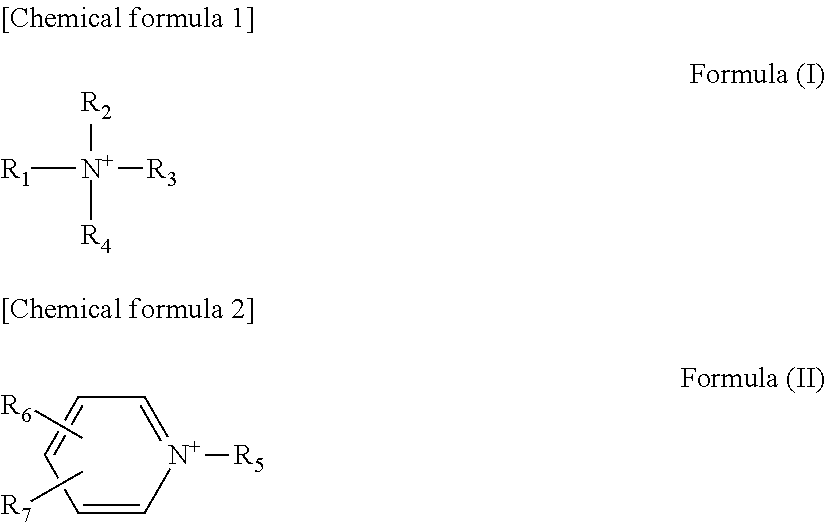Method for producing sizing agent-coated carbon fibers, and sizing agent-coated carbon fibers
- Summary
- Abstract
- Description
- Claims
- Application Information
AI Technical Summary
Benefits of technology
Problems solved by technology
Method used
Image
Examples
example 1
[0348]This example comprises the following first process and second process.
First Process: Process for Producing Carbon Bibers to be Used as a Starting Material
[0349]A copolymer consisting of 99 mol % of acrylonitrile and 1 mol % of itaconic acid was spun, and the obtained filaments were burned to obtain carbon fibers comprising 24,000 filaments in total, with a total fineness of 800 tex, a specific gravity of 1.8, a strand tensile strength of 6.2 GPa, and a strand tensile modulus of 300 GPa. Subsequently, the carbon fibers were electrolytically treated on the surface with 100 coulombs of electricity per 1 g of the carbon fibers by using, as an electrolyte, an ammonium hydrogencarbonate aqueous solution with a concentration of 0.1 mole / l. The electrolytically surface-treated carbon fibers were washed with water in succession and dried in heated air with a temperature of 150° C., to obtain the carbon fibers to be used as a starting material. The surface oxygen concentration (O / C) in ...
examples 2 to 5
First Process: Process for Producing Carbon Fibers to be Used as a Starting Material
[0351]The process was the same as that of Example 1.
Second Process: Process for Depositing a Sizing Agent on Carbon Fibers
[0352]Sizing agent-coated carbon fibers were obtained by the same method as that of Example 1, except that the ratio by mass of (A-1):(B-1) was changed in a range from 100:3 to 100:20 as shown in Table 1 in the second process of Example 1. The deposited amount of the sizing agent was 1 part by mass per 100 parts by mass of the surface-treated carbon fibers. The sizing agent-coated carbon fibers obtained were used to measure the interfacial shear strength (IFSS), and as a result, the IFSS values were 35 to 47 MPa. It was found that the adhesion was sufficiently high in every example. Among the examples, in the cases where the ratios by mass of (A-1):(B-1) were 100:3 or 100:6, the adhesion was very excellent. The results are shown in Table 1.
examples 6 to 10
First Process: Process for Producing Carbon Fibers to be Used as a Starting Material
[0358]The process was the same as that of Example 1.
Second Process: Process for Depositing a Sizing Agent on Carbon Fibers
[0359]Sizing agent-coated carbon fibers were obtained by the same method as that of Example 2, except that the heat treatment temperature was changed in a range from 180 to 260° C. while the heat treatment time was changed in a range from 45 to 480 seconds as shown in Table 2 in the second process of Example 2. The deposited amount of the sizing agent was 1 part by mass per 100 parts by mass of the surface-treated carbon fibers. The sizing agent-coated carbon fibers obtained were used to measure the interfacial shear strength (IFSS), and as a result, the IFSS values were 33 to 42 MPa. It was found that the adhesion was sufficiently high in every example. Among the examples, in the case where the heat treatment temperature was 220° C. while the heat treatment time was 90 seconds, t...
PUM
| Property | Measurement | Unit |
|---|---|---|
| Temperature | aaaaa | aaaaa |
| Time | aaaaa | aaaaa |
| Percent by mass | aaaaa | aaaaa |
Abstract
Description
Claims
Application Information
 Login to View More
Login to View More - R&D
- Intellectual Property
- Life Sciences
- Materials
- Tech Scout
- Unparalleled Data Quality
- Higher Quality Content
- 60% Fewer Hallucinations
Browse by: Latest US Patents, China's latest patents, Technical Efficacy Thesaurus, Application Domain, Technology Topic, Popular Technical Reports.
© 2025 PatSnap. All rights reserved.Legal|Privacy policy|Modern Slavery Act Transparency Statement|Sitemap|About US| Contact US: help@patsnap.com



